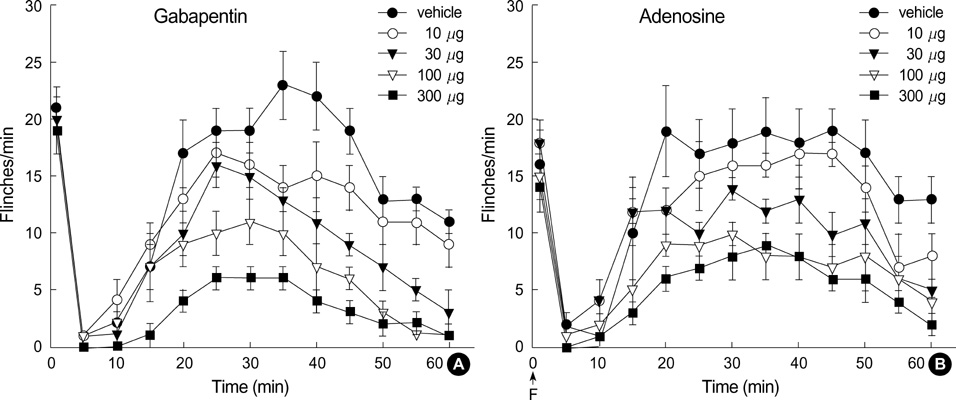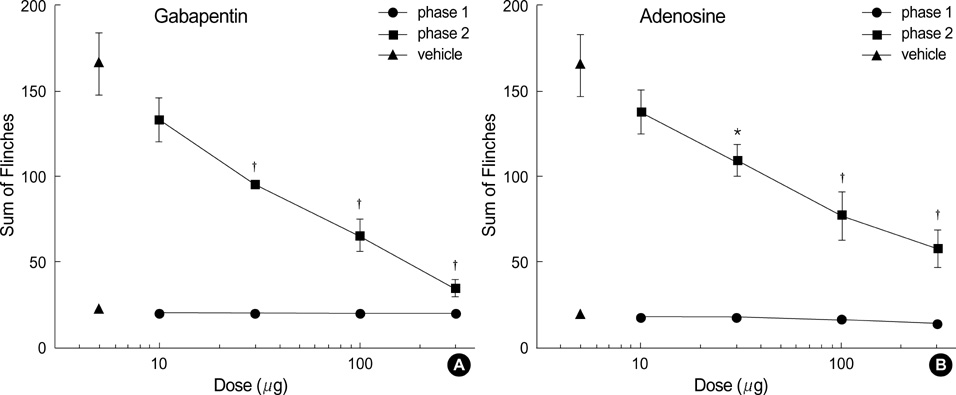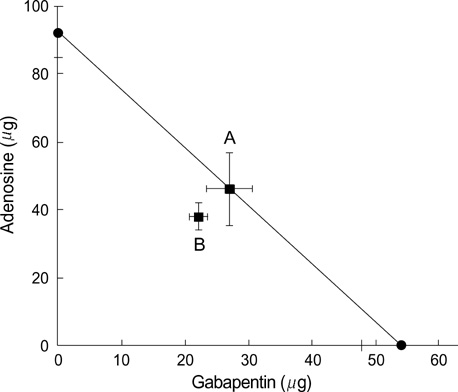J Korean Med Sci.
2004 Aug;19(4):581-585. 10.3346/jkms.2004.19.4.581.
Interaction between Intrathecal Gabapentin and Adenosine in the Formalin Test of Rats
- Affiliations
-
- 1Department of Anesthesiology and Pain Medicine, Chonnam National University, Medical School, Gwangju, Korea. mhyoon@chonnam.ac.kr
- KMID: 2157689
- DOI: http://doi.org/10.3346/jkms.2004.19.4.581
Abstract
- Spinal gabapentin and adenosine have been known to display an antinociceptive effect. We evaluated the nature of the interaction between gabapentin and adenosine in formalin-induced nociception at the spinal level. Male Sprague-Dawley rats were prepared for intrathecal catheterization. Pain was evoked by injection of formalin solution (5%, 50 microliter) into the hindpaw. After examination of the effects of gabapentin and adenosine, the resulting interaction was investigated with isobolographic and fractional analyses. Neither gabapentin nor adenosine affected motor function. Gabapentin or adenosine decreased the sum of the number of flinches during phase 2, but not during phase 1 in the formalin test. Isobolographic analysis, in phase 2, revealed an additive interaction between gabapentin and adenosine. Taken together, intrathecal gabapentin and adenosine attenuated the facilitated state and interacted additively with each other.
Keyword
MeSH Terms
-
*Adenosine/administration & dosage/metabolism/therapeutic use
*Amines/administration & dosage/metabolism/therapeutic use
*Analgesics/administration & dosage/metabolism/therapeutic use
Animals
*Cyclohexanecarboxylic Acids/administration & Dose-Response Relationship, Drug
Formaldehyde/*toxicity
Injections, Spinal
Male
Motor Activity/physiology
Pain Measurement
Rats
Rats, Sprague-Dawley
Research Support, Non-U.S. Gov't
*gamma-Aminobutyric Acid/administration & dosage/metabolism/therapeutic
Figure
Reference
-
1. Taylor CP, Gee NS, Su TZ, Kocsis JD, Welty DF, Brown JP, Dooley DJ, Boden P, Singh L. A summary of mechanistic hypotheses of gabapentin pharmacology. Epilepsy Res. 1998. 29:233–249.
Article2. Yoon MH, Yaksh TL. The effect of intrathecal gabapentin on pain behavior and hemodynamics on the formalin test in the rat. Anesth Analg. 1999. 89:434–439.
Article3. Field MJ, Holloman EF, McCleary S, Hughes J, Singh L. Evaluation of gabapentin and S-(+)-3isobutylgaba in a rat model of postoperative pain. J Pharmacol Exp Ther. 1997. 282:1242–1246.4. Yoon MH, Choi JI, Jeong SW. Spinal gabapentin and antinociception: mechanisms of action. J Korean Med Sci. 2003. 18:255–261.
Article5. Sawynok J. Purines in pain management. Curr Opin CPNS Invest Drugs. 1999. 1:27–38.6. Malmberg AB, Yaksh TL. Pharmacology of the spinal action of ketorolac, morphine, ST-91, U50488H, and L-PIA on the formalin test and an isobolographic analysis of the NSAID interaction. Anesthesiology. 1993. 79:270–281.
Article7. Poon A, Sawynok J. Antinociception by adenosine analogs and inhibitors of adenosine metabolism in an inflammatory thermal hyperalgesia model in the rat. Pain. 1998. 74:235–245.
Article8. Yamamoto S, Nakanishi O, Matsui T, Shinohara N, Kinoshita H, Lämbert C, Ishikawa T. Intrathecal adenosine A1 receptor agonist attenuates hyperalgesia without inhibiting spinal glutamate release in the rat. Cell Mol Neurobiol. 2003. 23:175–185.9. Sjolund KF, Sollevi A, Segerdahl M, Lundeberg T. Intrathecal adenosine analog administration reduces substance P in cerebrospinal fluid along with behavioral effects that suggest antinociception in rats. Anesth Analg. 1997. 85:627–632.
Article10. Chiari AI, Eisenach JC. Intrathecal adenosine: interactions with spinal clonidine and neostigmine in rat models of acute nociception and postoperative hypersensitivity. Anesthesiology. 1999. 90:1413–1421.11. Choca JI, Green RD, Proudfit HK. Adenosine A1 and A2 receptors of the substantia gelatinosa are located predominantly on intrinsic neurons: an autoradiography study. J Pharmacol Exp Ther. 1988. 247:757–764.12. Yaksh TL, Rudy TA. Chronic catheterization of the spinal subarachnoid space. Physiol Behav. 1976. 17:1031–1036.
Article13. Yoon MH, Choi JI. Pharmacologic interaction between cannabinoid and either clonidine or neostigmine in the rat formalin test. Anesthesiology. 2003. 99:701–707.
Article14. Tallarida RJ, Murray RB. Manual of pharmacologic calculations with computer programs. 1987. 2nd ed. New York: Springer-Verlag.15. Dougherty PM, Palecek J, Paleckova V, Sorkin LS, Willis WD. The role of NMDA and non-NMDA excitatory amino acid receptors in the excitation of primate spinothalamic tract neurons by mechanical, chemical, thermal, and electrical stimuli. J Neurosci. 1992. 12:3025–3041.
Article16. Jansen KL, Faull RL, Dragunow M, Waldvogel H. Autoradiographic localisation of NMDA, quisqualate and kainic acid receptors in human spinal cord. Neurosci Lett. 1990. 108:53–57.
Article17. Benoliel R, Tanaka M, Caudle RM, Iadarola MJ. Co-localization of N-methyl-D-aspartate receptors and substance P (neurokinin-1) receptors in rat spinal cord. Neurosci Lett. 2000. 291:61–64.
Article18. Yaksh TL. The spinal pharmacology of facilitation of afferent processing evoked by high-threshold afferent input of the postinjury pain state. Curr Opin Neurol Neurosurg. 1993. 6:250–256.19. Goldlust A, Su TZ, Welty DF, Taylor CP, Oxender DL. Effects of anticonvulsant drug gabapentin on the enzymes in metabolic pathways of glutamate and GABA. Epilepsy Res. 1995. 22:1–11.
Article20. Shimoyama M, Shimoyama N, Hori Y. Gabapentin affects glutamatergic excitatory neurotransmission in the rat dorsal horn. Pain. 2000. 85:405–414.
Article21. Maneuf YP, McKnight AT. Block by gabapentin of the facilitation of glutamate release from rat trigeminal nucleus following activation of protein kinase C or adenylyl cyclase. Br J Pharmacol. 2001. 134:237–240.
Article22. Shimoyama N, Shimoyama M, Davis AM, Inturrisi CE, Elliott KJ. Spinal gabapentin is antinociceptive in the rat formalin test. Neurosci Lett. 1997. 222:65–67.
Article23. Kaneko M, Mestre C, Sanchez EH, Hammond DL. Intrathecally administered gabapentin inhibits formalin-evoked nociception and the expression of fos-like immunoreactivity in the spinal cord of the rat. J Pharmacol Exp Ther. 2000. 292:743–751.24. DeLander GE, Hopkins CJ. Involvement of A2 adenosine receptors in spinal mechanisms of antinociception. Eur J Pharmacol. 1987. 139:215–223.
Article25. Bouron A. Adenosine suppresses protein kinase A- and C-induced enhancement of glutamate release in the hippocampus. Eur J Neurosci. 1999. 11:4446–4450.
Article26. Wirkner K, Assmann H, Koles L, Gerevich Z, Franke H, Norenberg W, Boehm R, Illes P. Inhibition by adenosine A(2A) receptors of NMDA but not AMPA currents in rat neostriatal neurons. Br J Pharmacol. 2000. 130:259–269.
Article27. Kissin I, Stanski DR, Brown PT, Bradley EL Jr. Pentobarbital-morphine anesthetic interactions in terms of intensity of noxious stimulation required for arousal. Anesthesiology. 1993. 78:744–749.
Article28. Poon A, Sawynok J. Antinociception by adenosine analogs and an adenosine kinase inhibitor: dependence on formalin concentration. Eur J Pharmacol. 1995. 286:177–184.
Article
- Full Text Links
- Actions
-
Cited
- CITED
-
- Close
- Share
- Similar articles
-
- Effect of Serotonergic Receptors on the Antinociception of Intrathecal Gabapentin in the Formalin Test of Rats
- Analysis of Interaction between Intrathecal Gabapentin with MK801, 5,7-DKA or NBQX in the Rat Formalin Test
- Evaluation of the Interaction between Intrathecal 5-Hydroxytryptamine and Adenosine in the Formalin Test in a Rat Model
- Antinociceptive drug interaction between intrathecal vitamin E and gabapentin in the rat formalin test
- The Interaction of Gabapentin and N(6)-(2-phenylisopropyl)-adenosine R-(-)isomer (R-PIA) on Mechanical Allodynia in Rats with a Spinal Nerve Ligation




